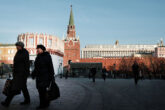June 02, 2022
Russia Is Down. But It’s Not Out.
The war in Ukraine has undoubtedly tarnished Russia’s standing as a great power.
Russia’s botched invasion of Ukraine, involving a retreat from Kyiv and many tactical blunders, has severely damaged the image of its military as a capable fighting force. The harm is more than reputational: Three months of fighting has dealt Russia heavy losses of troops and equipment. At home, meanwhile, sanctions and export controls — as well as the exodus of Russia’s brightest minds — are hitting the country’s already lackluster economy.
As a result, many in America and Europe are eager to dismiss Russia as a Potemkin power whose exalted status is at an end. Militarily battered and saddled with sanctions that some in Washington suggest are designed to weaken Russia, the Kremlin seems to no longer warrant the worry previously expended on it. The threat Russia poses to the West, in this view, has foundered on Ukrainian soil.
Yet such an assessment is premature. Yes, President Vladimir Putin made a strategic blunder, leading to a military debacle and destroying decades of relative economic stability. But it’s far too soon to write Russia off. Despite its failures in Ukraine, Russia retains the capacity and the will to continue to seriously challenge the United States and Europe. Russia may be down, but it’s not out.
Despite its failures in Ukraine, Russia retains the capacity and the will to continue to seriously challenge the United States and Europe.
In the past three months, vivid images of destroyed Russian tanks have filled our screens. And it’s true that Russia’s army, over the past three months, has been mauled. Russia has lost approximately 25 percent of its active tank force, over 30 aircraft and more than 10,000 troops. While the exact number is unknown, the casualties are significant, and the Russian military will struggle to sustain the war without resorting to some form of conscription.
But appearances can be deceptive. After all, many of the army’s initial failures stemmed from Mr. Putin’s misplaced assumption that the war would be short and sharp: Russian troops were simply not prepared or organized for a serious campaign. Yet in recent weeks, as Russia revised its war aims to focus on the Donbas in Ukraine’s east, Russian forces have adapted and begun correcting some of their earlier incompetence. Russia has been making incremental gains, revealing Ukraine’s military position to be precarious in some areas.
Read the full article from The New York Times.
More from CNAS
-
Former NATO Secretary Explains: What’s Next for Venezuela?
The recent strikes leading to the capture of Nicolas Maduro have raised significant questions about the future of Venezuela. Jim Townsend, CNAS adjunct senior fellow and forme...
By Jim Townsend
-
Zelensky Heads to Trump Meeting with Canada, EU Support
Jim Townsend, CNAS adjunct senior fellow and ex-deputy assistant for European and NATO policy, joined CTV News to discuss the demands Zelensky faces from Trump. Watch the ful...
By Jim Townsend
-
Ukraine Negotiations: Prospects and Pitfalls of Peace
This week Brussels Sprouts breaks down the latest negotiations on Ukraine. American officials told reporters that they had resolved or closed gaps around 90 percent of their d...
By Andrea Kendall-Taylor & Jim Townsend
-
Can the Global Order Be Saved? Not Without Punishing Russia
The only way to succeed in the urgent task of achieving a just peace settlement, therefore, is radically reshaping Russia’s calculus....
By Nicholas Lokker




